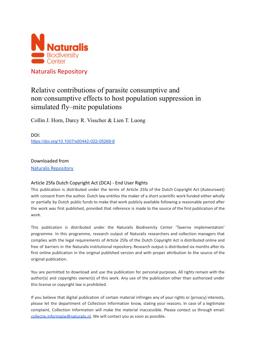2022-10-01
Relative contributions of parasite consumptive and non-consumptive effects to host population suppression in simulated fly–mite populations
Publication
Publication
Oecologia , Volume 200 - Issue 3-4 p. 339- 347
The “ecology of fear” framework was developed to describe the impacts predators have on potential prey and prey populations, outside of consumption/predation (i.e. non-consumptive effects, NCEs). This framework has recently been extended to symbiotic interactions such as host–parasite associations. Although the NCEs of predators and parasites on their individual victims can be measured experimentally, it is currently not known whether parasites can exert population-level effects on potential hosts through their NCEs. Modelling can be a useful tool for scaling individual-level NCEs to populations to determine impacts on host population growth. In this study, we used previously published data on the consumptive and non-consumptive effects of an ectoparasitic mite (Macrocheles subbadius) on a fruit fly (Drosophila nigrospiracula) to simulate populations experiencing fear (NCEs only), both fear and infection (consumption + NCEs) or neither. Populationlevel models indicate that NCEs alone were insufficient to reduce population growth. In fact, host populations experiencing NCEs but not infection had slightly larger final populations than unexposed populations (by ~ 550 flies). This result suggests there is compensation (i.e. increased daily reproduction that overcomes shorter lifespans) among exposed flies. By contrast, the consumptive effects of parasites suppressed the growth of simulated host populations, and this deleterious impact grew non-linearly with infection prevalence.
| Additional Metadata | |
|---|---|
| doi.org/10.1007/s00442-022-05268-8 | |
| Oecologia | |
| Organisation | Staff publications |
|
Horn, Collin J., Visscher, D., & Luong, Lien T. (2022). Relative contributions of parasite consumptive and non-consumptive effects to host population suppression in simulated fly–mite populations. Oecologia, 200(3-4), 339–347. doi:10.1007/s00442-022-05268-8 |
|
